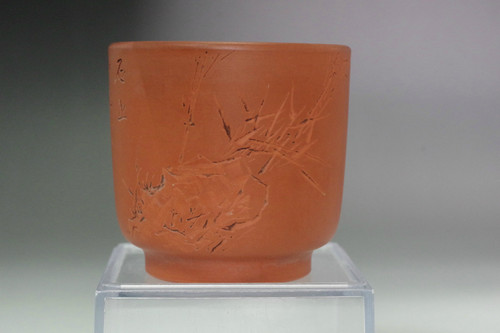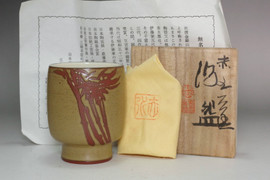Ito Sekisui made Vintage MUMYOI pottery cup #5080
- SKU:
- 5080
- Shipping:
- Free Shipping
Width: approx. 7cm (2 3⁄4in)
Caliber: approx. 6.6cm (2 19⁄32in)
Weight: 128g
The marks of bottom: Aikawa Mumyoi, Sado Island Gold Mines
Note: This pottery piece was crafted by ITO SEKISUI, a name synonymous with excellence in Japanese ceramics. The 5th-generation SEKISUI has been recognized as a Living National Treasure, underscoring the family's legacy in the art of pottery. Unfortunately, it is unclear which generation of SEKISUI created this particular piece, but its craftsmanship reflects the high standards associated with the SEKISUI lineage.
Mumyoi pottery
Mumyoi is a type of red soil which contains a rich amount of iron oxide which is produced from around the Gold Mine, and the Mumyoi pottery uses it as its pottery clay, which is then baked at high temperatures.
The character of the clay is such that it requires special work such as polishing while raw and then polishing it with sand after baking it.
In addition, the pottery clay goes through “elutriation” – a way to get rid of sand and impurities in the process of balancing the clay particles – using a 200-mesh sieve which makes the baked pottery clay shrink by around 30% due to the loss of these particles.
Therefore the product is extremely hard and when hit it makes a clear metallic sound and the more use it gets the more it shines.
The Mumyoi Ware products are gaining attention as a means of improving the taste of tea, alcohol, beer and coffee.
In China, Mumyoi had been used as a type of herbal medicine to cure hemostasis since ancient times, but as they did not know the source of the effect they seemingly named it Mumyoi (no name). In Japan this was gathered only around the Sado Gold Mine. It was a byproduct of mining operations during the 1640s – the height of the gold rush on Sado Island after the discovery of the Aikawa mines.
The history of Mumyoi ware began with Ito Jinpei creating Raku Ware using the Mumyoi produced from the Sado Mines in the 2nd year of Bunsei (1819).
Afterward, Miura Jozan (1836-1903) realized that Mumyoi produced from the Sado Mines has a very similar nature to Yixing clay. He doubled his efforts to change the usual Mumyoi ware, which was quite fragile, into strong pottery similar to the pottery created from the Yixing kiln in China, and he completed a piece of strong, high-temperature Mumyoi pottery. Tea tools in Mumyoi ware became popular among people who like green tea because they made tea delicious like Chinese Yixing ware.
According to a record, the famous shogunate retainer, Katsu Kaishu bought tea tools from Miura Jozan.
In 2003 Mumyoi Ware was registered as a National Important Intangible Cultural Property.
The Agency for Cultural Affairs is attempting to register Sado Aikawa gold mines in the World Heritage List now. Unfortunately, because of this, it became very difficult for potters to obtain Mumyoi from around Sado Aikawa gold mines because collecting the mine soil from the area was banned.
Ito Sekisui
1838-1872
male
munyoi pottery
Real name was Tomitaro. In 1857, assumed the artist name of Sekisui and used the soil from Aikawa, Sado (Mumyoi ware) to improve the Raku ware started by Ito Jinpei from the head family. Founded Sekisui ware by making tea sets and sake cups using shidei techniques. Passed away at the age of 35.
From the Meiji era on, the 2nd generation Kenzo and the 3rd generation Kotaro succeeded Sekisui ware. Inlay work and other techniques were added during this process to make improvements. The 5th generation Ito Sekisui is the holder of an important intangible cultural asset.














